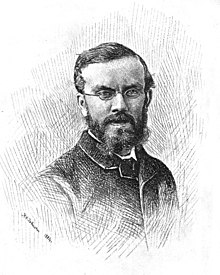William Alexander Forbes
William Alexander Forbes (born June 25, 1855 in Cheltenham , † January 14, 1883 in Shonga, Niger ) was an English zoologist who researched in Brazil and the Niger Delta.
Life
Forbes was the second son of James Staats Forbes and his wife Ann (nee Bennett). His father was chairman of the London, Chatham and Dover Railway and the District Railway . From 1866 to 1872 Forbes was educated at Kensington School and Winchester College . In 1872 he studied German in Aachen . From 1873 to 1875 he studied medicine at the University of Edinburgh and from 1875 to 1876 at University College London . His great interest and talent for biology, which Forbes devoted himself to, became apparent early on during his studies.
Thanks to the influence of his friend Alfred Henry Garrod (1846-1879) Forbes attended St John's College in Cambridge from 1876 . Here he obtained the Bachelor of Arts magna cum laude in the Tripos of Natural Sciences in 1879 . He was then elected a Fellow of the St John's College. In the same year he was appointed prosector of the Zoological Society of London to succeed the late Garrod . Forbes became Garrod's literary executor and in 1881 published a collection of Garrod's scientific papers with biographical notes. In the same year Forbes established the monotypical genus Garrodia for the gray-backed petrel , which was described by John Gould in 1841 as Oceanites nereis . In addition to his zoological work, Forbes taught Comparative Anatomy at Charing Cross Hospital Medical School.
Between 1879 and 1882 Forbes worked for the gardens of the Zoological Society, about which he wrote some scientific articles. Among the best known are On the anatomy of the passerine birds (Proceedings of the Zoological Society, 1880–82), On the contributions to the anatomy and classification of birds made by Professor Garrod (The Ibis, 1881) and On the anatomy of the petrels collected during the voyage of HMS Challenger (Zoology of the Challenger, 4, Pt. 11, 1882).
In the summer of 1880 Forbes set out on a short expedition into the forests of Pernambuco in Brazil. Here he collected, among other things, the holotype of the Kragenweihs, a bird of prey that was not scientifically described by Harry Kirke Swann (1871-1926) until 1922 and recognized as an independent species in the 1980s. In 1881 Forbes published an account of this trip in The Ibis journal. In 1882 he traveled to the United States to visit his American brothers.
On July 19, 1882, he sailed from Liverpool on an expedition to tropical Africa. Starting with the Niger Delta , he wanted to research the fauna. However, he had to cancel this project due to the non-arrival of a steamer upstream from Shonga. He decided to return to England immediately. Shortly after Christmas of the same year he fell ill with fever and dysentery, from the consequences of which he died on January 14, 1883 at the age of 28. His remains were brought to England and buried in Wickham Cemetery in Kent on April 1, 1884 .
Dedication names
The collar consecration ( Leptodon forbesi ), the forbes ringed plover ( Charadrius forbesi ) and the forbesbird ( Curaeus forbesi ) are named after William Alexander Forbes .
literature
- FE Beddard: The collected papers of the late William Alexander Forbes The Ibis, 5th ser., 1 (1883): 387-392
- GT Bettany: Forbes, William Alexander (1855-1883) , rev. Yolanda Foote, Oxford Dictionary of National Biography, Oxford University Press, 2004
| personal data | |
|---|---|
| SURNAME | Forbes, William Alexander |
| BRIEF DESCRIPTION | English zoologist |
| DATE OF BIRTH | June 25, 1855 |
| PLACE OF BIRTH | Cheltenham |
| DATE OF DEATH | January 14, 1883 |
| Place of death | Shonga on Niger |
